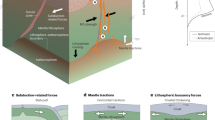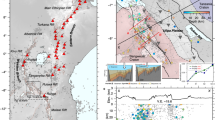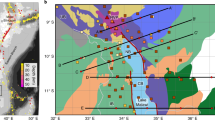Abstract
Continental rifting is the poorly understood thermomechanical process by which continents break up and new ocean basins form. Two dominant styles of continental rifting are recognized1. Crevice style rifts are characterized by initial graben formation, local uplift of the graben shoulders, and little or no volcanism. Arch-volcanic rifts exhibit an initial doming of the crust, extensive volcanism, and late-stage graben formation. The prevailing expla-nation for the two styles is that crevice rifts form in response to regional horizontal stresses, principally derived from the inter-action of the lithospheric plates along their edges, whereas arch-volcanic rifts are thought to be the result of mantle convection currents which upwell directly beneath the rift axis2. We propose an alternative working model of continental rifting in which both styles initiate in response to regional horizontal stresses. The different surface expressions of the two styles are explained in terms of differences in the mode of failure at different kinds of pre-existing weaknesses in the continental lithosphere, rather than differences in the nature of the driving forces involved.
This is a preview of subscription content, access via your institution
Access options
Subscribe to this journal
Receive 51 print issues and online access
$199.00 per year
only $3.90 per issue
Buy this article
- Purchase on Springer Link
- Instant access to full article PDF
Prices may be subject to local taxes which are calculated during checkout
Similar content being viewed by others
References
Milanovsky, E. E. Tectonophysics 15, 65–70 (1972).
Sengör, A. M. & Burke, K. Geophys. Res. Lett. 5, 419–421 (1978).
Wilson, J. T. Nature 207, 343–347 (1965).
McConnell, R. B. Bull. geol. Soc. Am. 83, 2549–2572 (1972).
King, B. C. in Tectonics and Geophysies of Continental Rifts (eds Ramberg, I. B. & Neumann, E. R.) 347–350 (Reidel, Dordrecht, 1978).
Fuchs, K. in Approaches to Taphrogenesis (eds Illies, J. H. & Fuchs, K.) 420–432 (Schweizerbart, Stuttgart, 1974).
Illies, J. H. in Tectonics and Geophysics of Continental Rifts (eds Ramberg, I. B. & Neumann, E. R.) 63–71 (Reidel, Dordrecht, 1978).
Sykes, L. R. Rev. Geophys. Space Phys. 16, 621–688 (1978).
Brace, W. F. & Kohlstedt, D. L. J. geophys. Res. 85, 6248–6252 (1980).
Meissner, R. The Continental Crust, 162–167 (Academic, New York, 1986).
Pollack, H. N. Earth planet. Sci. Lett. 80, 175–182 (1986).
Ballard, S. & Pollack, H. N. Earth planet. Sci. Lett. 85, 253–264 (1987).
Vink, G. E., Morgan, W. J. & Zhao, W. J. geophys. Res. 89, 10072–10076 (1984).
Dewey, J. F. in The Nature of the Lower Continental Crust (eds Dawson, J. B., Carswell, D. A., Hall, J. & Wedepohl, K. H.) 71–78 (Geological Society, London, 1986).
Chapple, W. M. Bull. geol. Soc. Am. 89, 1189–1198 (1978).
Kirby, S. H. Rev. Geophys. Space Phys. 21, 1458–1487 (1983).
Zienkiewicz, O. C. & Godbole, P. N. in Finite Elements in Fluids Vol. 1, Ch. 2 (eds Gallagher, R. H., Oden, J. T., Taylor, C. & Zienkiewicz, O. C.) (Wiley, New York, 1975).
Zienkiewicz, O. C. The Finite Element Method 93–118 (McGraw-Hill, London, 1977).
Walcott, A. B. J. geophys. Res. 75, 3941–3954 (1970).
Huebner, K. H. & Thornton, E. A. The Finite Element Method for Engineers 423–427 (Wiley, New York, 1982).
Buck, W. R. Earth planet. Sci. Lett. 77, 362–372 (1986).
Ringwood, A. E. Composition and Petrology of the Earth's Mantle 150–169 (McGraw-Hill, New York, 1975).
Barberi, F., Santacroe, R. & Varet, J. in Continental and Oceanic Rifts. Geodyn. Ser. Vol. 8 (ed. Palmason, G.) 293–309 (AGU, Washington, D.C., 1982).
Mohr, P. Trans. Am. geophys. Un. 68, 721–730 (1987).
Jones, C. H. Tectonics 6, 449–473 (1987).
Kerr, R. A. Science 239, 978–979 (1988).
Burchfiel, B. C., Hodges, K. V. & Royden, L. H. J. geophys. Res. 92, 10422–10426 (1987).
Rowley, D. B. & Sahagian, D. Geology 14, 32–35 (1986).
Wernicke, B. Can. J. Earth Sci. 22, 108–125 (1984).
Lister, G. S., Etheridge, M. A. & Symonds, P. A. Geology 14, 246–250 (1986).
Author information
Authors and Affiliations
Rights and permissions
About this article
Cite this article
Dunbar, J., Sawyer, D. Continental rifting at pre-existing lithospheric weaknesses. Nature 333, 450–452 (1988). https://doi.org/10.1038/333450a0
Received:
Accepted:
Issue Date:
DOI: https://doi.org/10.1038/333450a0
This article is cited by
-
Activity criterion of pre-existing fabrics in non-homogeneous deformation domain
Science China Earth Sciences (2010)
-
Samovar: a thermomechanical code for modeling of geodynamic processes in the lithosphere—application to basin evolution
Arabian Journal of Geosciences (2010)
Comments
By submitting a comment you agree to abide by our Terms and Community Guidelines. If you find something abusive or that does not comply with our terms or guidelines please flag it as inappropriate.



